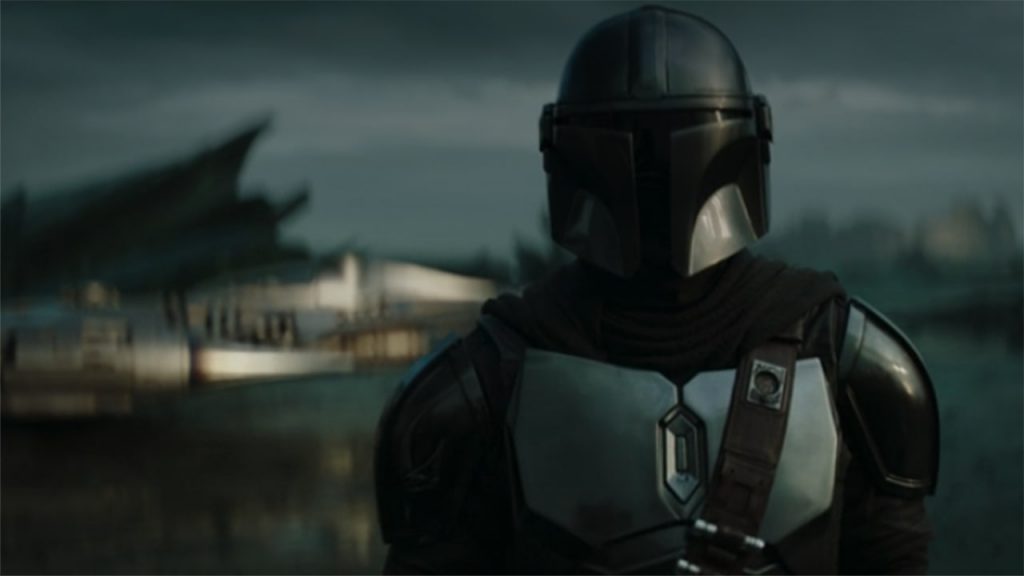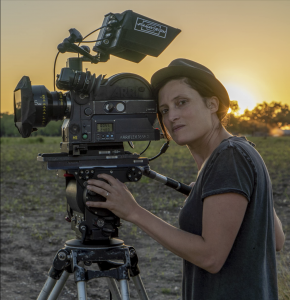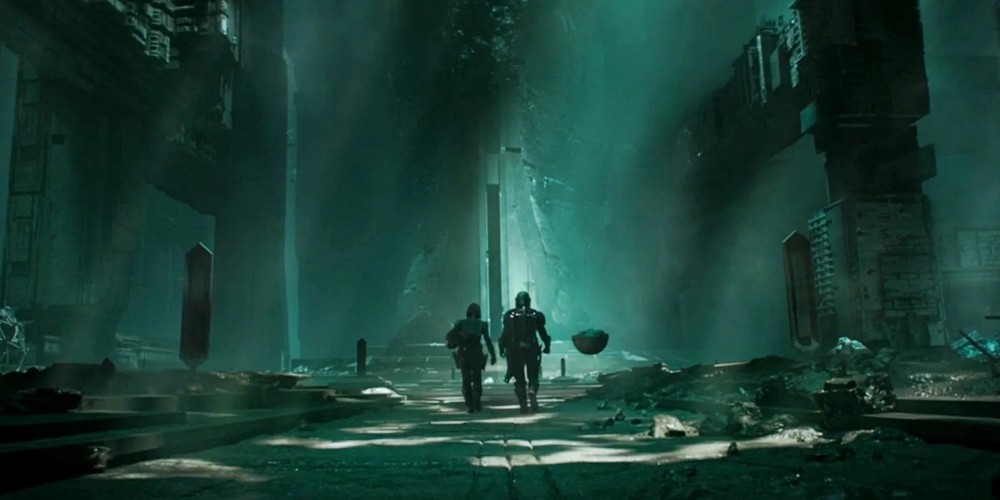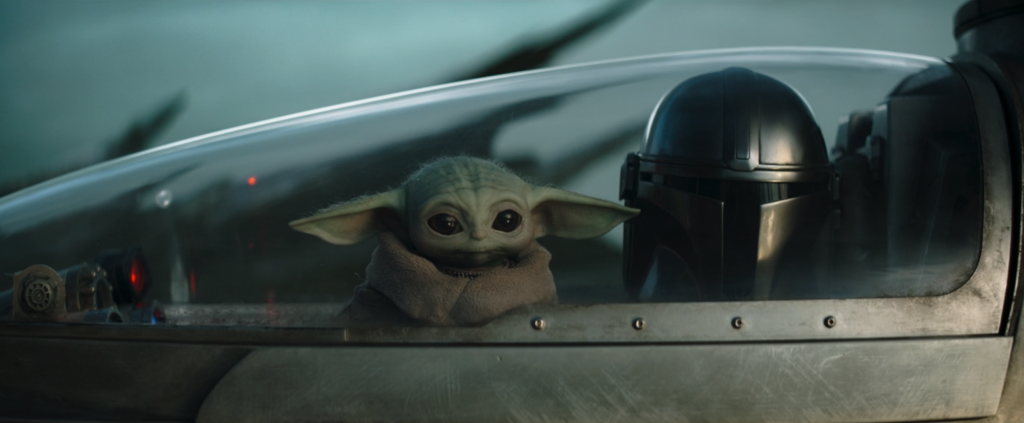
In season three of The Mandalorian, Din Djarin (played by Pedro Pascal) returns to his home planet to restore his standing as a warrior. In a gripping episode called “The Mines of Mandalore,” Djarin and Grogu face deadly challenges, including attacks by Alamites and immersion in the Living Waters.
In creating the planet, visual effects supervisor Grady Cofer said, “We knew the audience was really anticipating going there, and that we had to get everything right.” Key to the episode’s success was director Rachel Morrison.
An acclaimed cinematographer who received an Oscar nomination for Mudbound, Morrison has turned to directing in recent years, helming episodes of American Crime Story, The Morning Show, and Hightown. Her feature directing debut, Flint Strong, will be released in 2024.
She came to The Mandalorian through director Rick Famuyiwa, having shot his projects Dope (2015) and Confirmation (2016). Rick was a supervising producer on the season and knew Morrison would make a great addition to the team.
Morrison spoke with Below the Line via Zoom from her home in California.

Below the Line: Did you have any trouble adjusting to the Star Wars universe?
Rachel Morrison: It was certainly a new challenge, but I found it all exciting to be honest. I am one of the very small handful of people who are not particularly well versed in the Star Wars universe, but perhaps that worked in my favor because it allowed me to see everything with fresh eyes.
I had been hearing about The Mandalorian since it premiered and reading about all the new tech that enabled shooting on the Volume stage so I felt extremely fortunate to be presented with an amazing opportunity for discovery and exploration.
BTL: What surprised you about working with volume?
Morrison: It made me realize how meaningful it is to the filmmaking process for everyone from the director to the set grips to be able to see what they are making. I’ve done a lot of blue/green screen and traditional composite work. I remember on Black Panther I was given a previs system in pre-production where I could digitally explore Warrior Falls.
But my camera team, who didn’t arrive until production, never had that chance. When we shot those scenes, there was a natural tendency to favor the built portion of the set, so I had to remind legend operator Scott Sakamoto, “There’s a waterfall over there,” or “Don’t forget that direction will look incredible in post.
Sometimes in a heavily blue-screen environment, only the department heads even know what the final shot will (hopefully) look like. Others don’t even know if it’s a day or night scene. I think there is more value than people realize in the shared experience of creating together. It’s empowering when people walking by the monitor can see that you’re making something special. It allows everyone to take pride in it and invest in it. And it puts more control in the camera by doing some of the post upfront.
To that end, I found it incredibly fulfilling to be able to visualize more specifically what you’re framing through the lens. I believe that you come to set prepared with a shot list and a plan, but you’re always ready to pivot if magic happens. That could be the sun setting “just so” or the way the light kisses metal at the angle of refraction.
The volume enables interactive lighting with characters in space and creates reflections in specular highlights. That meant I could set a shot and then adjust on the day if there was a more dynamic angle, just as I would on location.
Another nice thing about the volume is you can cheat the set by literally rotating the virtual world. It’s a bit mind-blowing how much control you have in camera.
BTL: How much of the effects were ready for you to see?
Morrison: The worlds were built. In fact, a very special thing about The Mandalorian is that Grady and the team let me help build them! Some aspects of those worlds get a shine or a polish later on. Characters might get extended. For example, the mechanical spider was a template that came to life in post.
It was such a gift that in the height of Covid, I was given an Occulus system and the ability to explore Mandalore and Tattoine months before I shot my episode. I could literally move around in the space with my DP Dave Klein and pick angles together. Then we could tell Grady and his team any notes we had. They would make micro-adjustments to the worlds, such as adding foreground or shifting the height of a highlight in the background. It was incredible to be included in that part of the process.
BTL: A long sequence in your episode takes place underwater. Can you explain how you shot it?
Morrison: What I found unique to the Mandalorian team is everybody is trying for a level of realism and gravity that makes it feel like we’re in a world we understand. Underwater photography is tricky because there’s a weight to the way you move through liquid. What happens to hair and to materials—for years all of those things have been the hardest for technology to capture. The easy solve is to make digital people move through a digital space.
Rather than do that, we photographed Katee Sackhoff’s [who plays Bo-Katan Kryze] own movements, using dry-for-wet to indicate how the body is actually going to move through this space. Then you can add the water and lighting components. You’re building off real actors, real performances. Even if they decide later to replace it with a digital performance, they have something to match it to.
When I was prepping for Mudbound, I tested film vs digital, always knowing we couldn’t afford to shoot on film. But the tests were a way to provide a baseline for how best to match digital with film in a way that feels granular and filmic. It’s the same thing here. By filming Katee swimming, we were starting from something organic and real.
BTL: It must have gotten complicated positioning the stunt team.
Morrison: Yeah, they were on wires and rigs, jumping off ledges and hanging from jib arms, dry-swimming while we dollied down the track. It was a blast!

BTL: As a director, how do you get performances from a man in a mask and a puppet?
Morrison: That’s partly why I said yes to The Mandalorian. I wanted to answer that question for myself. What I discovered is that a lot of the same rules apply. They’re sometimes amplified, such as the importance of close eyelines in those moments when you’re trying to connect characters.
Grogu’s eyes are incredibly emotive, but even so positioning the camera so Grogu and Djarin are looking at each other straight in the eyes is something very different from a three-quarter angle or a profile.
I also discovered the Mandalorian is a masterclass in body performance. We use so many assets besides our face to express feelings and emotions. So much of Djarin’s performance is in how he moves through space and how nuanced he is with his gestures or gait.
BTL: What I found interesting about your episode is that when they’re in the mines, you’re basically making a silent film. There’s some dialogue for exposition, but you have to carry that story in purely visual terms.
Morrison: That was fun for me. I don’t know how they match directors to episodes, but my particular episode really spoke to my background in cinematography, to my skillset in being able to tell a story visually. The challenge was how to vary the visuals, as we spent a good amount of the episode retracing our own steps.
BTL: So do you have a previs for everything?
Morrison: Every director on The Mandalorian uses previs in the way that benefits them the most. There may be directors who love to have it all figured out, and just shoot the previs on the day. But I prefer shotlists because I don’t want to pin myself into a blocking before working with the actor. I like the room for discovery on the day. I will know beforehand that I want a certain scene to be a oner, but I won’t pre-determine exactly where the camera will travel unless it’s technically complicated and needs to be designed to specification.
The way I used previs here as I mentioned was to affect the world. “This background could be stronger. Can we add more fallen buildings?” Or, “Is this run of volume long enough to walk through the amount of dialogue we have?” You’re using the previs to be as prepared as possible, to choose roughly the angles you want, to have a solid game plan.
Typically I shotlist for one camera, even when I have two. That liberates the B camera to find something additive. But I never force a second camera if it results in two compromised angles instead of one intentioned and emotional one.
In this episode we tended toward more single camera moves — it was designed to be very experiential, a lot of moving masters, leading and following and experiencing Mandalore through Din and Grogu’s eyes. What’s it like to return home to destruction? Or for a baby to move through a scary place all alone?

BTL: What was it like working with DP David Klein?
Morrison: Dave’s an amazing collaborator and human. I think there’s a fear that because I’m a DP too, we were going to step all over each other. It was quite the opposite. Because of my background, I can anticipate my DP’s needs. I can understand if Dave needs an extra 30 minutes to light something.
Even in the real world, when I’m scouting commercials as a director, I’m often doing that ahead of the DP. So I’m looking for things like, Is it south-facing? Are we going to lose the sun behind a mountain or get screwed because we can’t fit a crane where it’s needed? I can help take some of their concerns off my cinematographer’s plate so they can focus on more creative things.
Dave really understood my approach, of having it feel experiential. I mean, this is a big episode for Grogu, right? Baby saves the day. So what does that look like to a child? To have to overcome fear for someone you love. Dave knew immediately what I was getting at. It was a very natural collaboration.
BTL: What was the biggest challenge?
Morrison: Weirdly, it was Grogu’s carriage. It’s a cumbersome piece of equipment. You have to lay track for it. It has to have its own jib. We have so many gimbals and devices now I thought there would have been a simpler way to move the carriage, such as putting it on a Steadicam. But it had all been tried before. Nothing worked as well as a double-dolly method. That meant any time we wanted to move Grogu it was a tedious operation.
The other challenge for this episode was that we were the first to incorporate a new system into the Unreal engine. In addition to tracking the lens position, we were also using separate points to track interactive lighting, such as Din’s headlamp. We were figuring out the technical details together, which is one of the joys of a project like this. When it worked, everybody was elated. When it got buggy, and froze up, we felt collective pain.
BTL: What’s happening with Flint Strong, your feature directing debut?
Morrison: It’s finished, and I’m incredibly proud of it. Brian Tyree Henry is amazing and Ryan Destiny, my lead, will blow you away. But the wait to release is crazy to me. The studio wants to tie it to the Olympics and to open while kids are out of school, so we come out in theaters August 9, 2024. Patience isn’t my strong suit but I’m doing my best…
The Mandalorian season 3 is now available to stream on Disney+.





